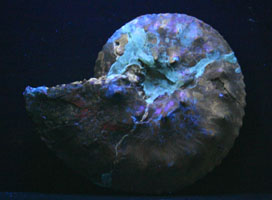The Placenticeras genus is characterized by a tightly coiled (moderately involute umbilicus), lenticular (lens shaped), shell. The umbilicus (center) is well rounded and moderately deep. The flanks (sides) are broad, convex and ornamented, in some species, with ribs and tubercles along the umbilicus and midflank. The keel or venter (outside edge) is narrow and flat to slightly concave and protects the siphuncle. The siphuncle is the tube which connects the chambers allowing the animal to fill them with water or air to rise and lower in the water. Placenticeras has a very complex suture pattern with 10 to 14 divided, deep, narrow-necked saddles, lobes, and sinuses.
Placenticeras intercalare is differentiated from other Placenticeras species by its smaller size (up to 10 inches), thicker whorl section, narrower flanks, and greater ornamentation. It has two rows of well-defined tubercles on its flanks. one near the umbilicus and the other approximately two-thirds of the distance from the umbilicus toward the ventral edge. Minor broad, low, rounded ribs connect the tubercles. Small clavate tubercles are found on both edges of the venter.
Both images were taken under both, long and short UV lights. The yellow and orange fluorescing minerals are calcite and any green would be chalcedony. Any purple is the reflection of the UV lights off the light colored non-fluorescing minerals in the specimen.
This specimen can also be found in our fossil ammonite section. It will have the same item number without the trailing "F."
Placenticeras: Placenta - means flat cake, ceras - means horn.
Placenticeras intercalare 
Quantity in Basket: None
Code: FAI-201F
Price: $450.00
Shipping Weight: 1.58 pounds
Time: Upper Cretaceous, Upper Campian, approximately 74.5-73.4 million years ago.
Location: Pierre Shale, South Dakota
Dimensions: 4-1/2 inches